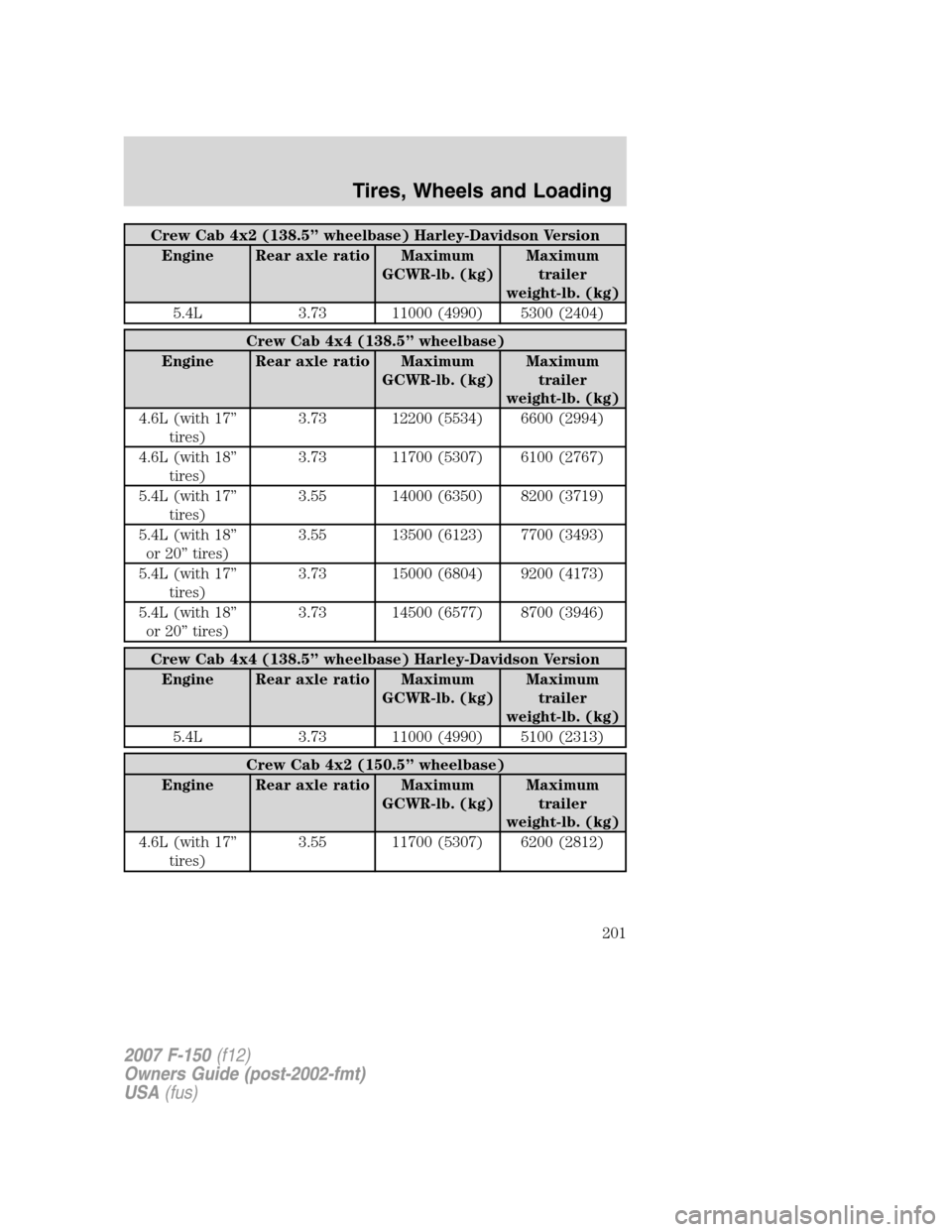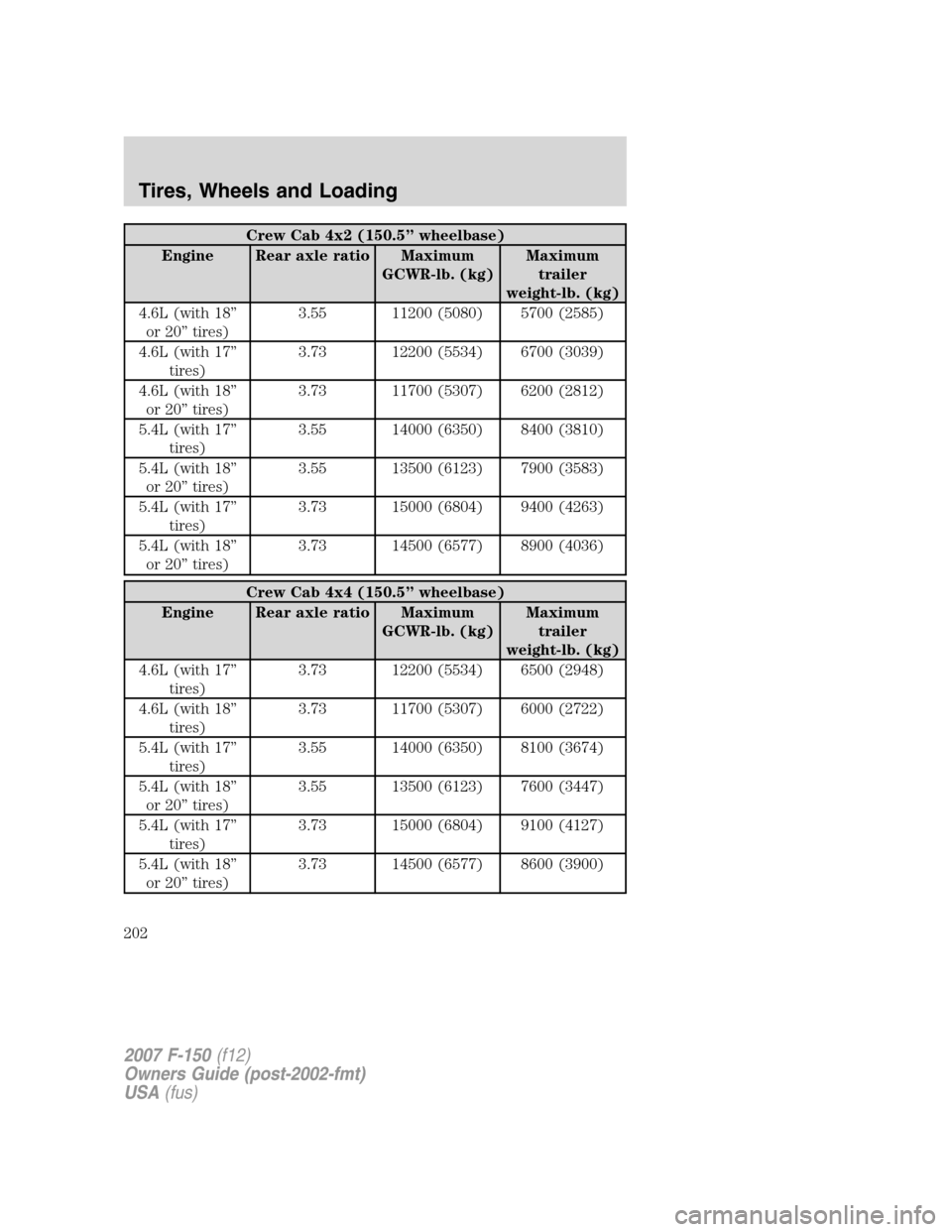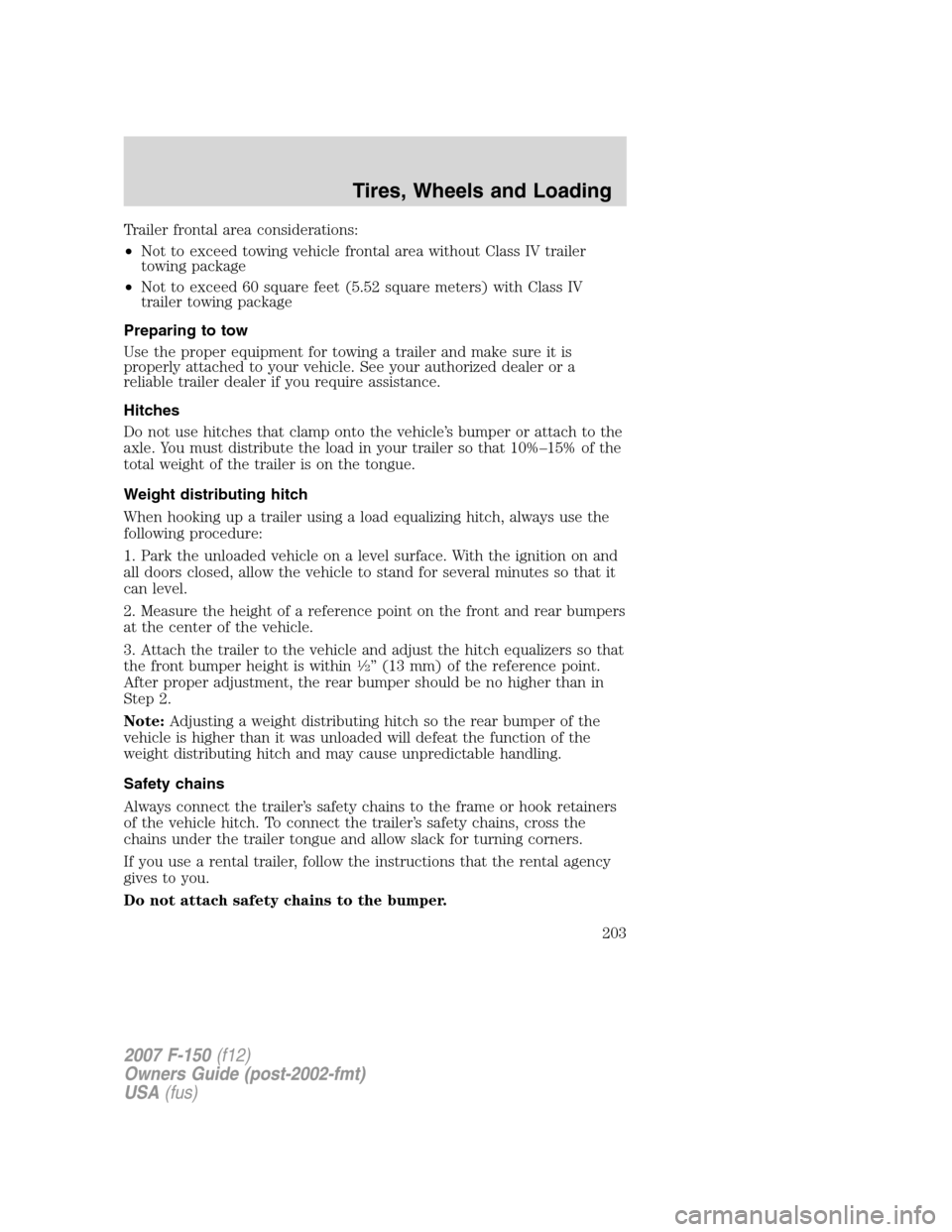Page 197 of 344
Regular Cab 4x4 (144.5” wheelbase)
Engine Rear axle ratio Maximum
GCWR-lb. (kg)Maximum
trailer
weight-lb. (kg)
5.4L (with 17”
tires)3.55 14000 (6350) 8500 (3856)
5.4L (with 18”
or 20” tires)3.55 13500 (6123) 8000 (3629)
5.4L (with 17”
tires)3.73 15000 (6804) 9500 (4309)
5.4L (with 18”
or 20” tires)3.73 14500 (6577) 9000 (4082)
5.4L Heavy Duty 4.10 15300 (6940) 9500 (4309)
SuperCab 4x2 (132.5” wheelbase)
Engine Rear axle ratio Maximum
GCWR-lb. (kg)Maximum
trailer
weight-lb. (kg)
4.6L (with 17”
tires)3.55 11500 (5216) 6300 (2858)
4.6L (with 18”
tires)3.55 11000 (4989) 5800 (2630)
4.6L (with 17”
tires)3.73 12000 (5443) 6800 (3084)
4.6L (with 18”
tires)3.73 11500 (5216) 6300 (2858)
5.4L (with 17”
tires)3.55 13000 (5897) 7600 (3447)
5.4L (with 18”
tires)3.55 12500 (5670) 7100 (3221)
5.4L (with 17”
tires)3.73 13500 (6123) 8100 (3674)
5.4L (with 18”
tires)3.73 13000 (5897) 7600 (3447)
2007 F-150(f12)
Owners Guide (post-2002-fmt)
USA(fus)
Tires, Wheels and Loading
197
Page 198 of 344
SuperCab 4x2 (144.5” wheelbase)
Engine Rear axle ratio Maximum
GCWR-lb. (kg)Maximum
trailer
weight-lb. (kg)
4.6L (with 17”
tires)3.55 11700 (5307) 6500 (2948)
4.6L (with 18”
tires)3.55 11200 (5081) 6000 (2722)
4.6L (with 17”
tires)3.73 12200 (5534) 7000 (3175)
4.6L (with 18”
tires)3.73 11700 (5307) 6500 (2948)
5.4L (with 17”
tires)3.55 14000 (6350) 8600 (3901)
5.4L (with 18”
or 20” tires)3.55 13500 (6123) 8100 (3674)
5.4L (with 17”
tires)3.73 15000 (6804) 9500 (4309)
5.4L (with 18”or
20” tires)3.73 14500 (6577) 9000 (4082)
SuperCab 4x2 (163” wheelbase)
Engine Rear axle ratio Maximum
GCWR-kg (lb.)Maximum
trailer
weight-kg (lb.)
5.4L Heavy Duty 4.10 15300 (6940) 9500 (4309)
SuperCab 4x4 (132.5” wheelbase)
Engine Rear axle ratio Maximum
GCWR-lb. (kg)Maximum
trailer
weight-lb. (kg)
4.6L (with 17”
tires)3.55 11500 (5216) 6000 (2721)
4.6L (with 18”
tires)3.55 11000 (4990) 5500 (2494)
2007 F-150(f12)
Owners Guide (post-2002-fmt)
USA(fus)
Tires, Wheels and Loading
198
Page 199 of 344
SuperCab 4x4 (132.5” wheelbase)
Engine Rear axle ratio Maximum
GCWR-lb. (kg)Maximum
trailer
weight-lb. (kg)
4.6L (with 17”
tires)3.73 12000 (5443) 6500 (2948)
4.6L (with 18”
tires)3.73 11500 (5216) 6000 (2721)
5.4L (with 17”
tires)3.55 13000 (5897) 7300 (3311)
5.4L (with 18”
tires)3.55 12500 (5670) 6800 (3084)
5.4L (with 17”
tires)3.73 13500 (6123) 7800 (3538)
5.4L (with 18”
tires)3.73 13000 (5897) 7300 (3311)
SuperCab 4x4 (144.5” wheelbase)
Engine Rear axle ratio Maximum
GCWR-lb. (kg)Maximum
trailer
weight-lb. (kg)
4.6L (with 17”
tires)3.55 11700 (5307) 6200 (2812)
4.6L (with 18”
tires)3.55 11200 (5080) 5700 (2585)
4.6L (with 17”
tires)3.73 12200 (5534) 6700 (3039)
4.6L (with 18”
tires)3.73 11700 (5307) 6200 (2812)
5.4L (with 17”
tires)3.55 14000 (6350) 8300 (3765)
5.4L (with 18”
or 20” tires)3.55 13500 (6123) 7800 (3538)
5.4L (with 17”
tires)3.73 15000 (6804) 9300 (4218)
2007 F-150(f12)
Owners Guide (post-2002-fmt)
USA(fus)
Tires, Wheels and Loading
199
Page 200 of 344
SuperCab 4x4 (144.5” wheelbase)
Engine Rear axle ratio Maximum
GCWR-lb. (kg)Maximum
trailer
weight-lb. (kg)
5.4L (with 18”
or 20” tires)3.73 14500 (6577) 8800 (3992)
SuperCab 4x4 (163” wheelbase)
Engine Rear axle ratio Maximum
GCWR-lb. (kg)Maximum
trailer
weight-lb. (kg)
5.4L Heavy Duty 4.10 15300 (6940) 9300 (4218)
Crew Cab 4x2 (138.5” wheelbase)
Engine Rear axle ratio Maximum
GCWR-lb. (kg)Maximum
trailer
weight-lb. (kg)
4.6L (with 17”
tires)3.55 11700 (5307) 6400 (2903)
4.6L (with 18”
or 20” tires)3.55 11200 (5080) 5900 (2676)
4.6L (with 17”
tires)3.73 12200 (5534) 6900 (3130)
4.6L (with 18”
or 20” tires)3.73 11700 (5307) 6400 (2903)
5.4L (with 17”
tires)3.55 14000 (6350) 8500 (3856)
5.4L (with 18”
or 20” tires)3.55 13500 (6123) 8000 (3629)
5.4L (with 17”
tires)3.73 15000 (6804) 9500 (4309)
5.4L (with 18”
or 20” tires)3.73 14500 (6577) 9000 (4082)
2007 F-150(f12)
Owners Guide (post-2002-fmt)
USA(fus)
Tires, Wheels and Loading
200
Page 201 of 344

Crew Cab 4x2 (138.5” wheelbase) Harley-Davidson Version
Engine Rear axle ratio Maximum
GCWR-lb. (kg)Maximum
trailer
weight-lb. (kg)
5.4L 3.73 11000 (4990) 5300 (2404)
Crew Cab 4x4 (138.5” wheelbase)
Engine Rear axle ratio Maximum
GCWR-lb. (kg)Maximum
trailer
weight-lb. (kg)
4.6L (with 17”
tires)3.73 12200 (5534) 6600 (2994)
4.6L (with 18”
tires)3.73 11700 (5307) 6100 (2767)
5.4L (with 17”
tires)3.55 14000 (6350) 8200 (3719)
5.4L (with 18”
or 20” tires)3.55 13500 (6123) 7700 (3493)
5.4L (with 17”
tires)3.73 15000 (6804) 9200 (4173)
5.4L (with 18”
or 20” tires)3.73 14500 (6577) 8700 (3946)
Crew Cab 4x4 (138.5” wheelbase) Harley-Davidson Version
Engine Rear axle ratio Maximum
GCWR-lb. (kg)Maximum
trailer
weight-lb. (kg)
5.4L 3.73 11000 (4990) 5100 (2313)
Crew Cab 4x2 (150.5” wheelbase)
Engine Rear axle ratio Maximum
GCWR-lb. (kg)Maximum
trailer
weight-lb. (kg)
4.6L (with 17”
tires)3.55 11700 (5307) 6200 (2812)
2007 F-150(f12)
Owners Guide (post-2002-fmt)
USA(fus)
Tires, Wheels and Loading
201
Page 202 of 344

Crew Cab 4x2 (150.5” wheelbase)
Engine Rear axle ratio Maximum
GCWR-lb. (kg)Maximum
trailer
weight-lb. (kg)
4.6L (with 18”
or 20” tires)3.55 11200 (5080) 5700 (2585)
4.6L (with 17”
tires)3.73 12200 (5534) 6700 (3039)
4.6L (with 18”
or 20” tires)3.73 11700 (5307) 6200 (2812)
5.4L (with 17”
tires)3.55 14000 (6350) 8400 (3810)
5.4L (with 18”
or 20” tires)3.55 13500 (6123) 7900 (3583)
5.4L (with 17”
tires)3.73 15000 (6804) 9400 (4263)
5.4L (with 18”
or 20” tires)3.73 14500 (6577) 8900 (4036)
Crew Cab 4x4 (150.5” wheelbase)
Engine Rear axle ratio Maximum
GCWR-lb. (kg)Maximum
trailer
weight-lb. (kg)
4.6L (with 17”
tires)3.73 12200 (5534) 6500 (2948)
4.6L (with 18”
tires)3.73 11700 (5307) 6000 (2722)
5.4L (with 17”
tires)3.55 14000 (6350) 8100 (3674)
5.4L (with 18”
or 20” tires)3.55 13500 (6123) 7600 (3447)
5.4L (with 17”
tires)3.73 15000 (6804) 9100 (4127)
5.4L (with 18”
or 20” tires)3.73 14500 (6577) 8600 (3900)
2007 F-150(f12)
Owners Guide (post-2002-fmt)
USA(fus)
Tires, Wheels and Loading
202
Page 203 of 344

Trailer frontal area considerations:
•Not to exceed towing vehicle frontal area without Class IV trailer
towing package
•Not to exceed 60 square feet (5.52 square meters) with Class IV
trailer towing package
Preparing to tow
Use the proper equipment for towing a trailer and make sure it is
properly attached to your vehicle. See your authorized dealer or a
reliable trailer dealer if you require assistance.
Hitches
Do not use hitches that clamp onto the vehicle’s bumper or attach to the
axle. You must distribute the load in your trailer so that 10%–15% of the
total weight of the trailer is on the tongue.
Weight distributing hitch
When hooking up a trailer using a load equalizing hitch, always use the
following procedure:
1. Park the unloaded vehicle on a level surface. With the ignition on and
all doors closed, allow the vehicle to stand for several minutes so that it
can level.
2. Measure the height of a reference point on the front and rear bumpers
at the center of the vehicle.
3. Attach the trailer to the vehicle and adjust the hitch equalizers so that
the front bumper height is within
1�2” (13 mm) of the reference point.
After proper adjustment, the rear bumper should be no higher than in
Step 2.
Note:Adjusting a weight distributing hitch so the rear bumper of the
vehicle is higher than it was unloaded will defeat the function of the
weight distributing hitch and may cause unpredictable handling.
Safety chains
Always connect the trailer’s safety chains to the frame or hook retainers
of the vehicle hitch. To connect the trailer’s safety chains, cross the
chains under the trailer tongue and allow slack for turning corners.
If you use a rental trailer, follow the instructions that the rental agency
gives to you.
Do not attach safety chains to the bumper.
2007 F-150(f12)
Owners Guide (post-2002-fmt)
USA(fus)
Tires, Wheels and Loading
203
Page 204 of 344

Trailer brakes
Electric brakes and manual, automatic or surge-type trailer brakes are
safe if installed properly and adjusted to the manufacturer’s
specifications. The trailer brakes must meet local and Federal
regulations.
Do not connect a trailer’s hydraulic brake system directly to your
vehicle’s brake system. Your vehicle may not have enough
braking power and your chances of having a collision greatly increase.
The braking system of the tow vehicle is rated for operation at the
GVWR not GCWR.
Trailer lamps
Trailer lamps are required on most towed vehicles. Make sure all running
lights, brake lights, turn signals and hazard lights are working. See your
authorized dealer or trailer rental agency for proper instructions and
equipment for hooking up trailer lamps.
Using a step bumper (if equipped)
The rear bumper is equipped with an integral hitch and only requires a
ball with a one inch (25.4 mm) shank diameter. The bumper has a 5,000
lb. (2,270 kg) trailer weight and 500 lb. (227 kg) tongue weight capacity.
If it is necessary to relocate the trailer hitch ball position, a
frame-mounted trailer hitch must be installed.
Driving while you tow
When towing a trailer:
•Keep your speed no faster than 70 mph (112 km/h) during the first
500 miles (800 km) of towing a trailer, and don’t make full throttle
starts.
•Turn off the speed control. The speed control may shut off
automatically when you are towing on long, steep grades.
•Consult your local motor vehicle speed regulations for towing a trailer.
•To eliminate excessive shifting, use a lower gear. This will also assist
in transmission cooling. (For additional information, refer to
Understanding the gearshift positions of the 4–speed automatic
transmissionin theDriving chapter.
•Anticipate stops and brake gradually.
2007 F-150(f12)
Owners Guide (post-2002-fmt)
USA(fus)
Tires, Wheels and Loading
204